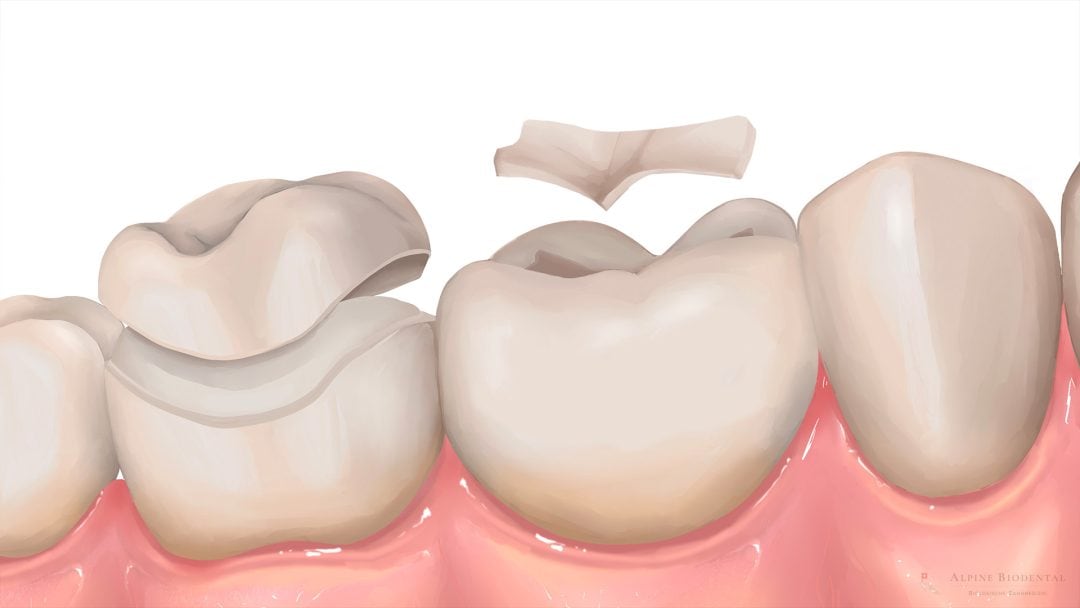Inlays and Onlays

The inlay or onlay is a dental treatment for a tooth after the removal of decay or an old amalgam filling. It is a high-quality and durable repair. The inlay or onlay can be crafted from various materials and precisely bonded or cemented into the damaged tooth.
When selecting materials, it is crucial to consider biological compatibility, durability, and aesthetics.
Our dental practice has its own dental laboratory and specializes in ceramic inlays. The materials are chosen for optimal biological compatibility and longevity. The entire manufacturing process is finely tuned to ensure the inlays’ optimal precision. Feel free to contact us at any time.
What are Inlays and Onlays?
Every day, our teeth are subjected to significant chemical and physical stress. Defects in teeth, caused by factors like cavities, should be promptly restored.
Inlays and Onlays are single-piece dental restorations designed to replace lost tooth structure. They do not differ in function but vary in shape and extent.
An Inlay is smaller in size and serves the inner part of the chewing surface. It is used when the tooth defect is relatively small.
An Onlay extends across the entire chewing surface of the tooth and is necessary when the defect is more extensive.
When are Inlays and Onlays used?
Every healthy tooth has an ideal anatomy to ensure optimal chewing, prevent food debris from getting stuck between teeth, and avoid overloading the jaw joints.
In various situations, repairing teeth with Inlays or Onlays is necessary:
1. Cavities (Dental Caries)
Acid from certain bacterial strains can etch holes in the tooth. This defect should be anatomically repaired, and for larger cavities, Inlays and Onlays are recommended.
2. Amalgam Removal/Amalgam Sanitation
Amalgam fillings have adverse health effects and should be removed with effective protective measures. After removal, the missing tooth structure can be well replaced with Inlays or Onlays.
3. Broken Tooth Segment
Occasionally, a part of the tooth may break off, especially in teeth that have been previously drilled or have cavities. The broken piece of the tooth can be restored with a high-quality Inlay or Onlay.
4. Reconstruction of Chewing Surfaces
Patients with incorrect tooth contacts often compress their jaw joints and force them into an unnatural position. This leads to remodeling of the jaw joints and surrounding tissues, affecting the entire body. This condition can result in Temporomandibular Joint Disorder of the Joints (TMJ), significantly impacting the quality of life.
As a therapy, the impact of abnormal tooth contacts must be eliminated through a special TMJ splint (MAGO splint), allowing the jaw joints to regenerate slowly. After the completion of jaw joint regeneration, TMJ symptoms should completely disappear. To prevent the old bite from causing harm to the regenerated jaw joints, the correct anatomy of the teeth must be restored. This is achieved through a complete reconstruction of the chewing surfaces with Inlays, Onlays, and Veneers. This reconstruction can also be combined with orthodontics.
For simplicity, the term “Inlay” is used in the following part of the article, but it includes Onlays as well.
What Materials are used for Inlays?
There are various materials used for the fabrication of inlays, each with its specific advantages and disadvantages that you should be aware of.
Ceramic Inlays – Ceramic Fillings
Ceramic inlays are also referred to as ceramic fillings and can be made from different types of ceramics.
Ceramic, as a material, is highly recommended in terms of biology, fit, durability, and aesthetics. It meets the requirements of high-quality aesthetic dentistry, allowing for the restoration of beautiful and anatomically correct teeth.
The precision and accuracy depend significantly on the type of ceramic and the manufacturing process.
Care must be taken during treatment and fabrication to maintain a minimum layer thickness to prevent later chipping and splintering.
With an experienced dental and dental technical team, ceramic can yield excellent results.
Gold Inlays – Gold Fillings
Gold has proven itself as a material for inlays over many decades in dentistry. Gold inlays are very precise and exhibit high durability.
However, gold has inferior aesthetic and health properties. The poor biocompatibility has been demonstrated in numerous samples and studies, including those by the IMD Institute for Medical Diagnostics Berlin.
Gold and Ceramic Inlays – Galvano Inlays
These inlays are a combination of ceramic and gold, with the majority being ceramic and the inner layer facing the tooth made of gold. Galvano inlays generally show excellent fit and high durability. However, the subpar biological compatibility makes them not recommended.
Titanium Inlays – Titanium Fillings
Titanium is well-known in dental implants, being the most commonly used material in implantology.
Titanium inlays have good fit and high durability. However, many patients find issue with the unaesthetic metallic-gray color.
Similar to gold, there are various health concerns associated with titanium.
Plastic Inlays – Plastic Fillings
There are various materials that can be used for plastic inlays. Depending on the quality of the material and the manufacturing process, the results can vary significantly.
With correct production in the dental laboratory using high-quality material, plastic inlays can be an alternative to ceramic inlays.
However, plastic does not match the biology and stability of ceramics and plays a subordinate role in inlays.
When an Inlay makes Sense– Filling, Inlay, or Crown?
As mentioned above, inlays are used to restore missing parts of a tooth, for example, after caries, in a single piece. This restores the tooth to its original anatomical shape.
If the caries is small, the defect can be replaced with a tooth filling made of plastic. This is often straightforward.
When the tooth defect is extensive, and anatomical reconstruction directly in the mouth is challenging, the inlay should be preferred. This allows the dental technician to optimally rebuild the ideal anatomy of the tooth. With a filling, there could be a risk that the contact with the adjacent tooth is too weak, allowing food residues to accumulate.
If you, as a patient, prefer the solution with the best compatibility and longest durability, you should opt for the ceramic inlay. Ceramic inlays are also ideal for aesthetic dentistry.
If the natural tooth crown is too severely damaged, it should be stabilized and restored with a ceramic crown. In such a case, a tooth filling or inlay would not be the right choice.
Therefore, the correct, individual choice of dental care is of great importance so that the stability and anatomy of the teeth can be ideally replicated. The dentist should always consider the biology of the material.
How are Inlays attached in the Tooth?
Inlays serve the function of replacing the missing tooth defect. To secure the missing piece, it is cemented or glued into the tooth.
Attachment with Cement
There are various cements used in dentistry. These adhere to both the tooth and the inlay, ensuring a strong and definitive bond.
Common cements include glass ionomer cement, zinc oxide-phosphate cement (Harvard cement), or carboxylate cement. These have proven themselves over many decades and can be used for attachment depending on the material of the inlay.
Cements, in general, have high biological compatibility and low susceptibility to moisture during the placement of the restoration.
However, depending on the material, their stability may be lower than that of plastic adhesives.
Attachment with Plastic Adhesive
Plastic adhesive is very similar in structure to the plastic used for plastic fillings. The adhesive is used along with a liquid bonding agent, creating a strong connection between the tooth, adhesive, and inlay.
This type of attachment is very strong and exhibits high stability.
Unfortunately, plastic adhesives contain many toxic and allergenic ingredients, compromising biological compatibility. Additionally, plastic adhesives are sensitive to moisture, which must be carefully considered during the placement of the inlay. Please refer to Environmental Dentistry for more information.
Treatment Procedure in two Appointments
This is the classic procedure for providing patients with inlays.
First Appointment:
- Removal of caries or amalgam filling
- Conservative adaptation of the existing tooth defect for the inlay
- Impression with hydrocolloid/silicone or digitally with an intraoral scanner
- Provisional filling to protect the tooth
The impression is sent to the dental technician, who manufactures the inlays in the dental laboratory. The production takes approximately 7 days when using an external dental technology laboratory.
Second Appointment:
- Careful removal of the provisional filling and cleaning of the tooth defect
- The inlay is attached with cement or plastic adhesive
- Excess cement or adhesive is thoroughly removed
- The tooth contacts are checked and adjusted if necessary
Treatment Procedure in one Appointment (Chairside)
The two treatment appointments can be combined into a single day.
The first part of the treatment is conducted in the morning. Afterward, the patient has a few hours of break. During this time, the inlays can be manufactured either in the dental laboratory or using the CEREC system.
After the break, the second part of the treatment takes place.
This way, the inlays can be produced and placed on the same day.
Such a chairside treatment is only possible if the practice has its own dental laboratory or with the help of CEREC.
In-House Dental Laboratory
In an in-house dental laboratory, the dental technician can concentrate 100% on the patients of the dental practice. Consequently, lab-fabricated, highly precise inlays can be manufactured and placed on the same day.
Lab-fabricated inlays have the advantage of being ground with the highest accuracy. A 5-axis milling machine with super-fine 0.3mm wide cutters can produce optimal fit and precision.
As a result, inlays have an excellent fit, and the cement gap can be minimized.
CEREC
CEREC stands for CEramic REConstruction. It is a procedure for dental practices to quickly and straightforwardly manufacture ceramic inlays.
Here too, the inlay treatment is completed in a single day.
The dentist takes a digital impression with an intraoral scanner, sends the information to a special milling machine that grinds the inlays from ceramic blocks.
This process is simple and also provides a very good result.
Dr. Tobias Steinherr M. Sc.
Inlays and onlays offer stable and durable tooth restoration. Feel free to contact us.

Frequently asked Questions about Inlays
If you are considering getting an inlay and are not sure about your decision, please read the questions and answers on this topic.
With a healthy bacterial flora in the mouth, inlays can last for 15 to 30 years. In our practice, we can build up the oral flora and keep it in a stable range.
Many patients do not need an injection and find the treatment less painful. However, local anesthesia may be necessary.
It depends very much on your own perception of pain. You may need a local anesthetic.
As a rule, cements and adhesives take about 24 hours to harden completely. However, you can eat normally during this time.
Durability is highly dependent on a healthy oral bacterial flora. This can be permanently optimized and stabilized in the dental practice.
Depending on the material, inlays can break. This is particularly the case with ceramic inlays that are too thin. However, if the correct procedure is followed, it is very rare.
Ceramic and plastic can be used very well in esthetic dentistry. The esthetic appearance of ceramic in particular is ideal for this purpose.
Further information
The further information is intended to give you a better overview of the subject area.